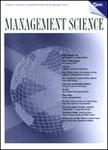-
作者:Nicolaou, Nicos; Shane, Scott; Cherkas, Lynn; Hunkin, Janice; Spector, Tim D.
作者单位:University of Cyprus; University System of Ohio; Case Western Reserve University; University of London; King's College London
摘要:We used quantitative genetics techniques to compare the entrepreneurial activity of 870 pairs of monozygotic (MZ) and 857 pairs of same-sex dizygotic (DZ) twins from the United Kingdom. We ran model-fitting analyses to estimate the genetic, shared environmental and nonshared environmental effects on the propensity of people to become entrepreneurs. We found relatively high heritabilities for entrepreneurship across different operationalizations of the phenomenon, with little effect of family e...
-
作者:Haefliger, Stefan; von Krogh, Georg; Spaeth, Sebastian
作者单位:Swiss Federal Institutes of Technology Domain; ETH Zurich
摘要:Code reuse is a form of knowledge reuse in software development that is fundamental to innovation in many fields. However, to date there has been no systematic investigation of code reuse in open source software projects. This study uses quantitative and qualitative data gathered from a sample of six open source software projects to explore two sets of research questions derived from the literature on software reuse in firms and open source software development. We find that code reuse is exte...
-
作者:de Bettignies, Jean-Etienne
作者单位:Queens University - Canada
摘要:We model financial contracting in entrepreneurial ventures. In our incomplete contracts framework, the entrepreneur can design contracts contingent on three possible control right allocations: entrepreneur control, investor control, and joint control, with each allocation inducing different effort levels by both the entrepreneur and the investor. We find that a variety of contracts resembling financial instruments commonly used in practice, such as common stock, straight and convertible prefer...
-
作者:Verter, Vedat; Kara, Bahar Y.
作者单位:McGill University; Ihsan Dogramaci Bilkent University
摘要:The people living and working around the roads used for hazardous material (hazmat) shipments face the risk of suffering undesirable consequences of an accident. The main responsibility to mitigate the hazmat transport risk at a population zone belongs to the government agency with jurisdiction over that region. One of the common policy tools is to close certain road links to vehicles carrying hazmats. In effect, the road network available to dangerous goods carriers can be determined by the r...

